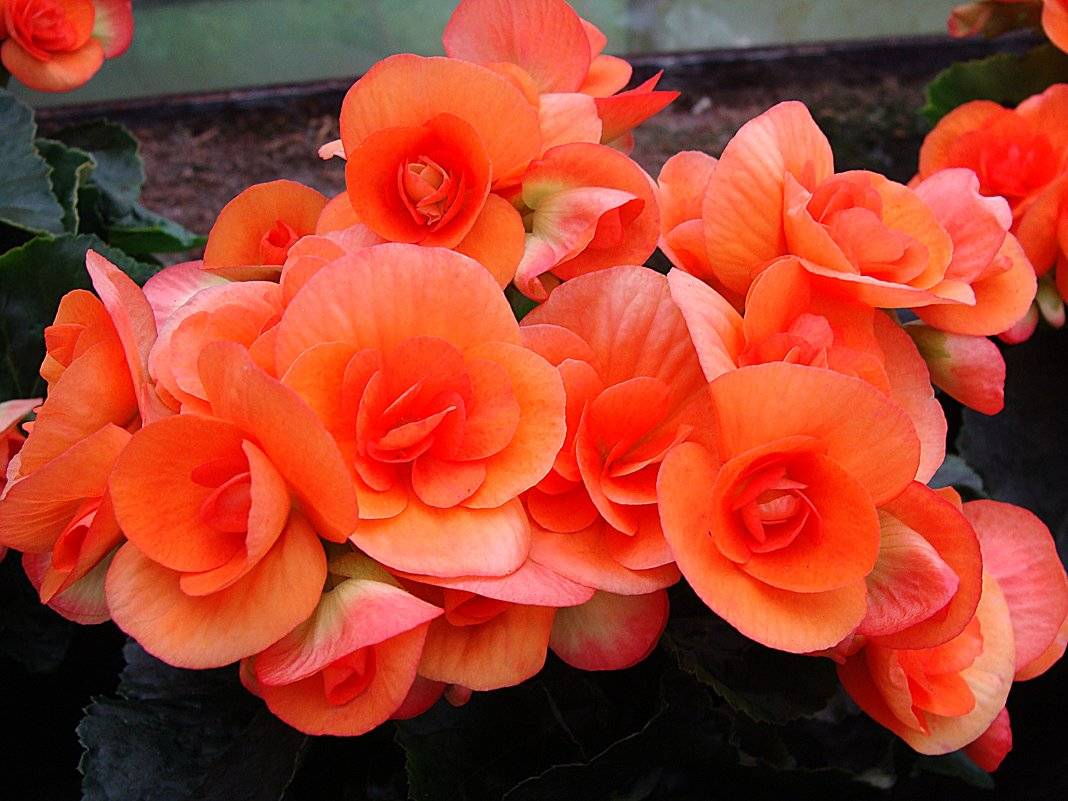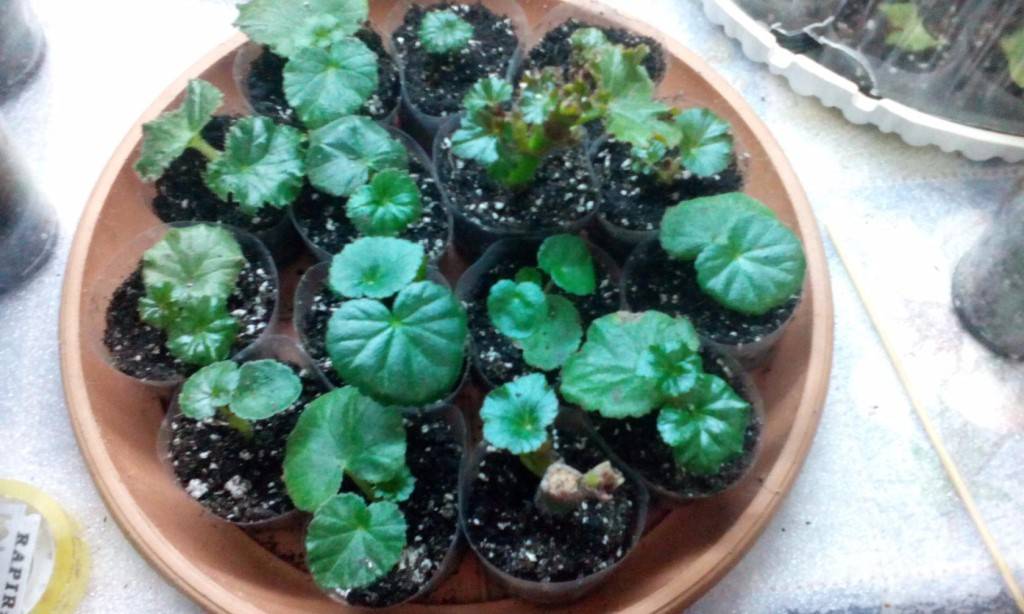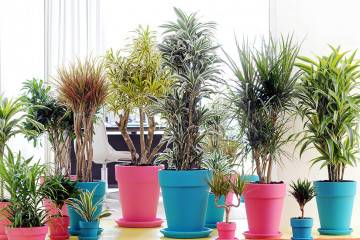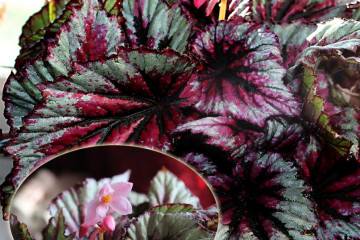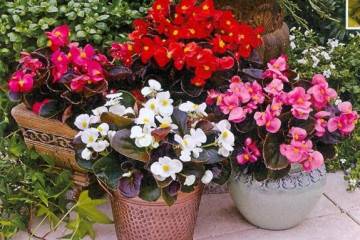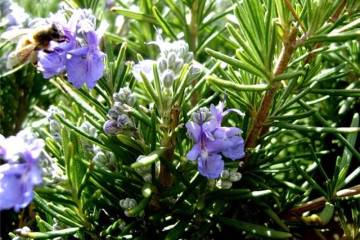Begonia Elatior - planting and care at home
Content:
The Begoniev family are evergreen shrubs with an abundance of flowers of different sizes. Through the efforts of breeders, varieties have been developed that are adapted for growth in various climatic conditions. The most tenacious variety is the Elatior begonia (Begonia Elatior, flowering begonia). The plant is grown and planted in herbariums, parks and squares, public buildings.
Description of the flower
The main function of this type of flowers is decorative. The leaves are heart-shaped. The support system is a straight stem from 15 to 60 cm. It can grow as a small shrub, but there are also loach plants - creeping shoots around solid objects.
Common varieties
Many varieties of Elatior begonias are bred in the main florist of Europe - the Netherlands. Certain species are best suited to difficult climates.
- Borias. Distantly resembles a rose bush. Large buds of lilac or scarlet color are white at the edges. The leaves have a sheen, the stem is small up to 30 cm high. The plant does not require special care.
- Annabelle. Differs in inflorescence of a light shade with a lemon-yellow heart. The variety is adapted to both indoor and outdoor conditions.
- Baladin. The sturdy lush stem is strewn with an abundance of flowers at all levels, varying in size and color. Together, there can be large and tiny red buds of all shades: pale, bloody, rich or pinkish. Due to the flowering nature of begonia, Baladin is used as a living gift (in a pot) at official events and is more often found on window sills.
- Renaissance. Able to grow up to 60 cm in height. The variant adapted to the indoor climate weakens in open soil. Inflorescences are red or dark orange. The petals and leaves are wavy with many tips.
- Grace. Tall bushes are native to the Asian tropics. Scarlet flowers open up to twice a year and can last for more than three months. The buds are formed at the tips of the stems, the leaves are elongated.
Healing properties
The plant secretes active substances (phytoncides) that inhibit microbes and reduce their number. To suppress infections and purify the air, Elatior is often kept in crowded places: hospitals, schools, kindergartens.
Begonia juice heals damaged tissue (burns, cuts) and relieves muscle pain. It can be used both in the form of a drink (50/50 with boiled water) and as a filler for a compress (abundant wetting of the tissue and applying to the affected areas).
Briefly about the history of appearance
The homeland of the plant is dense forests of warm southern regions: Central Africa, South America, India and Southeast Asia. In the Caribbean, scientists compiled the first description of flowers.
The Elatior variety was bred artificially by crossing the Socotran begonias with other species. The German breeder O. Rieger, after a series of experiments, improved the plants: he increased their vitality, resistance to fungi and parasites, and resistance to temperature fluctuations.
For commercial and decorative purposes, the color, shape of the flowers, the length and growth of the stem changed: from a small houseplant to a full-fledged park loach.
Features of caring for begonia elatior at home
Through the efforts of breeders, the finickyness of the plant has decreased, the varieties easily take root in cool climates. However, begonia remains a whimsical species: it requires constant conditions of detention, and feels the slightest changes in the environment. It is important to follow the rules in handling flowers, so they will live longer, and the flowers will retain their brightness.
Temperature
For Elatior begonia varieties, a comfortable habitat is between 21 ° C and 25 ° C during the day and from 12 ° C to 15 ° C at night. Although the flower does not need tropical heat, it should be kept warm.
Lighting
A useful and suitable option for begonias is moderate daylight sunshine. The flowers cannot stand the scorching rays: burns appear on the leaves, the petals fall off. You need to put the flower pot in a lighted place, but not in the open rays of the sun. Daylight hours should last up to 13-14 hours.
In winter and late autumn, it costs less lighting time, and does not require artificial support. Being in the shade is undesirable, since the buds and the bush itself are decreasing in size.
Watering
The plant needs water regularly: at least 1 time every 3 days (in winter - once a month). It is worth watering the ground in small portions with settled water at room temperature. The stem and roots do not tolerate flooding, but are more tolerant of lack of moisture.
Begonia Elatior rots easily with abundant watering and excess water in the pot. After 10-20 minutes. after watering, when excess moisture accumulates in the pan, it must be poured out.
Spraying
A sprinkler is used when it is necessary to humidify the air around the plant or to treat leaves in the evening. The ingress of water on the flowers is undesirable, since for begonias this is a stressful situation that threatens to throw off the petals.
Humidity
Tropical origin makes itself felt - Elatior is sensitive to air humidity. The optimal level is 65-70% in warm and 55-60% in cold seasons. In a dry room, the indicator can be maintained by spraying water around the plant from a spray bottle.
Priming
Elatior feels great in loose soil without lumps, easily forming a root system in it. The soil should allow air and water to pass through; the plant will not live long in heavy and dense soil.
Top dressing
Fertilizers are needed for the plant during flowering and growth, from the first days of spring to early autumn, every 2-3 weeks. At first, it is worth feeding with saturated mineral supplements; closer to summer, the concentration should be reduced. The plant will make it clear that there is too much organic matter in the soil when the flowers begin to fade and lose color.
Features of winter care
Begonia Elatior is bred as a plant that can bloom in winter. Nevertheless, the dormant regime remains in the winter months. In comfortable conditions and with proper care, the flower retains unfading buds. Daylight hours are enough for the plant. A cold snap threatens the bushes with death.
Although the plant does not "fall asleep" for the winter, processing and watering should be reduced. You cannot feed him at such a time.
When and how it blooms
With skillful and competent care, Elatior begonia can bloom all year round. In warmth and comfort, it develops at a rapid pace.
Types of flowers
There are two types of flowers on the Elatior begonia bushes: male (with stamens) and female (with pistils). Pollination occurs between inflorescences both within one plant and between several bushes. By mixing pollen of different varieties, you can get a hybrid.
For a permanent flowering of begonias, some of the female buds can be removed.
Flower shapes
The opened buds can resemble roses, carnations, other flowers, it all depends on the variety. They can be white, purple, lemon, orange, scarlet or pale red. The petals can be either straight or wavy at the edges.
Flowering period
Active development with the blooming of buds occurs:
- from early June to September (for most species);
- from November to mid-summer (for varieties that bloom in winter).
Certain varieties of Elatior begonias are capable of blooming all year round.
Pruning
Elatior blooms intensively, you will have to trim the ends of the shoots regularly. The weakening parts of the stem are cut off with a sharp knife or pruner in spring or autumn.
To achieve the bulkiness of the bush, pinching is carried out. For Elatior begonias, this is a stressful moment, which is why new flowers will bloom 2-3 weeks later. It is necessary to shorten the length of the branches of the bush up to 4-6 cm. So the bush will rather grow additional shoots from ripe buds.
How Elatior begonia reproduces
They increase the plant population both by seeds and by vegetative methods: by means of cuttings and young branches. All three methods have their own characteristics and differ in the complexity of implementation.
Germinating seeds
Traditional option. It will take a lot of time and effort to breed a population in this way. The source material is purchased from specialty stores. For planting to be successful, the seeds must be prepared.
- First, they are placed in a weak (1%) solution of potassium permanganate for 30-40 minutes.
- After extraction and washing with water, the seeds are placed in a container with peat.
Containers or pots are closed on top with foil, plastic or glass and placed on a pallet filled with water, since future roots need moisture. Plants need to be aired regularly, 5-10 minutes. a day will be enough.
The seeds will germinate by the middle of the third week. Shoot picking occurs at the end of the eighth week of development.
Rooting cuttings
Cutting is a popular and simple method. The basis for breeding is the ends of the branches of the stem, about 10 cm long, with the presence of buds. The fresh cut must be kept in a solution that stimulates root growth.
There are two ways to propagate begonia by rooting a twig:
- in soft warm water in a transparent vessel. While the cutting is in the water, the decayed sections of the cut must be removed. After growing the roots up to 1.5-2 cm, the sprout is placed in loose soft soil;
- in prepared moist soil from soil for begonias, sand and peat (in a ratio of 2: 1: 1). The shoot should be rooted to a depth of 2 cm. The container with the shoot is closed in a transparent jar until condensation forms, after which it is ventilated for several minutes.When leaves appear, the cutting is transplanted into a larger pot.
By dividing the bush
Reproduction in this way requires accuracy. It is used when transplanting flowers into a new pot. After removing from old dishes, the plant is cleaned of old large leaves and stem fragments. Having placed the bush in water, a fresh shoot with buds is cut from its rhizome with a sharp knife. A child seedling is root-treated and placed in a separate pot.
Transfer
It is permissible to replant the bush after flowering is complete. A soil change is carried out annually upon reaching the age of four, then the flower does not need it. Begonia rhizomes feel comfortable in small vessels (they fill the light soil of the pot faster), a large pot is not needed.
There should be holes at the bottom of the container for moisture to escape. The lowest layer is drainage, sphagnum or similar material is preferred. Calcined earth is poured next in turn.
The last step is to transplant a clod of earth with the roots of the plant. The free space around it is filled with earth.
Possible growing problems and diseases
All flowers are susceptible to ailments, and Elatior is no exception. But most of the diseases are curable. It is only important to notice them in a timely manner and prevent further deterioration of the condition of the flowers.
- Drops buds and leaves. The plant lacks light. The pot with a bush should be exposed to fresh air in a sunlit place.
- The leaves turn pale. The soil is saturated with organic matter. Change of soil will help.
- The tips of the leaves dry. The flower warns of a lack of water. The air around the leaves and stem should be humidified with a sprayer. Withered inflorescences, dried out processes and leaves must be removed immediately.
- The lower leaves fall off. The ground is dry, or the plant is too warm. Lack of moisture will correct abundant watering. Also, the plant could freeze and needs warmer conditions.
Pests
Aphids or spider mites may appear on the leaves of the plant, giving themselves away by the appearance of white threads on the bush. If there are few pests, it is permissible to remove them with a damp cotton pad or napkin. In case of a large lesion or for prophylaxis, drugs against pests (malofos or any other insecticide) are used.
Other problems:
- decrease in size - lack of mineral and organic fertilizers. The soil must be enriched with top dressing;
- black bloom at the rhizome and decay of the bush are signs of excess moisture. Reduce watering and move the pot to a room with drier air;
- green and white bloom indicates mold or powdery mildew. Here, the environment with a higher temperature is saved and treated with benomyl or another flower preparation.
Signs and superstitions
Begonia Elatior rumor did not endow miraculous abilities, but there is an unspoken rule: flowers are often placed in educational institutions, in offices associated with mental work. It is believed that the plant helps in painstaking work, maintains clarity of mind and creative thinking of employees.
The reason begonia has gained such a reputation is because it acts as a natural filter, purifying and humidifying the air. Elatior is an amazing example of combining benefits and pleasant appearance, as the plant decorates the environment and allows you to breathe easily and naturally.




